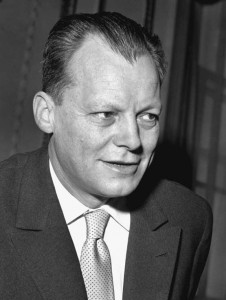“Hello. My name is Fred Stein, I’m a photographer, left-wing, and I would like to take your picture.”
This is how Fred Stein used to strike up a conversation with people he hoped to portray. Between 1933 and 1967 he managed to make more than 1,200 portraits this way. The words show he had not only the courage to approach people, but also a talent for quickly putting those who had caught his eye at ease.

Willy Brandt, New York 1957
© Estate of Fred Stein
Fred Stein took a passionate interest both in those he portrayed and their work. With André Malraux, Arthur Koestler, Egon Erwin Kisch, and countless other peers he discussed the political landscape in Europe of the 1930 and 40s. Willy Brandt and he became firm friends and remained so all their lives long, and likewise others whose portrait he made. In a letter of 10 May 1983, Brandt recalled:
“I met Fred Stein when we were both refugees and fighting the totalitarian Nazi regime with the rather modest means at our disposal. He was a man ahead of his time, an avant-garde and brilliant photographer, inspired by the commitment to justice and concern for truth so clearly reflected in his photographs. → continue reading
Fred Stein was only twenty-four years old when he had to flee Germany in 1933. A rabbi’s son and member of the Socialist Workers’ Party, he had studied law and hoped to work as an attorney, defending people’s rights. When he learned by chance that the Gestapo was planning to arrest him, he and his wife Lilo fled to Paris under the pretext of taking a honeymoon trip. In exile, the young couple was obliged to rethink its future.

Fred Stein, Berlin 1958
© Estate of Fred Stein
A Leica camera, the wedding present they had bought for themselves, proved to be the key to a new career. Fred Stein began taking photographs: street scenes in downtown Paris and portraits of celebrities, many of whom were German emigrants. In 1941 Fred and Lilo Stein, who by then had a little daughter, managed to flee a second time. They reached New York on one of the last ships out. There, Fred Stein once again devoted himself to shooting portraits and street scenes.
In 1958 Fred Stein returned to Germany for the first time in twenty-five years. He was prompted to do so by Will Grohmann’s planned publication of the book Deutsche Porträts [German Portraits]. Fred Stein was commissioned to photograph Konrad Adenauer, Heinrich Lübke, Ludwig Erhard, and other politicians, as well as artists, authors, and publishers, such as the young Axel Springer, or Rudolf Augstein. Yet apparently, many a German head he portrayed for the book posed a dilemma for him. → continue reading

Gisela and Philipp Kozower with their daughter Eva in August of 1932
© Friends of the Jewish Museum New York, Princeton; photographer: unknown, donated by Klaus M. Zwilsky
Lawyer Philipp Kozower was 37 when he married the 23-year-old medical student Gisela in 1931. A year later she gave birth to their first child, a daughter called Eva. The new parents had their picture taken with their baby in Berlin’s Monbijou Park: wearing a bright dress and straw hat, Gisela holds the baby towards the camera somewhat awkwardly, as if the picture should document that Eva exists.
By the time Eva’s sister Alice was born in 1934, the National Socialists had already enacted numerous laws against Jews as well as taken measures to exclude them from public life. Our online project “1933: The beginning of the end of German Jewry” presents a variety of source materials from the Jewish Museum Berlin’s archives that bear witness to the disenfranchisement of German Jews. A display case with photographs and letters in our permanent exhibition details the Kozower family’s story: → continue reading


